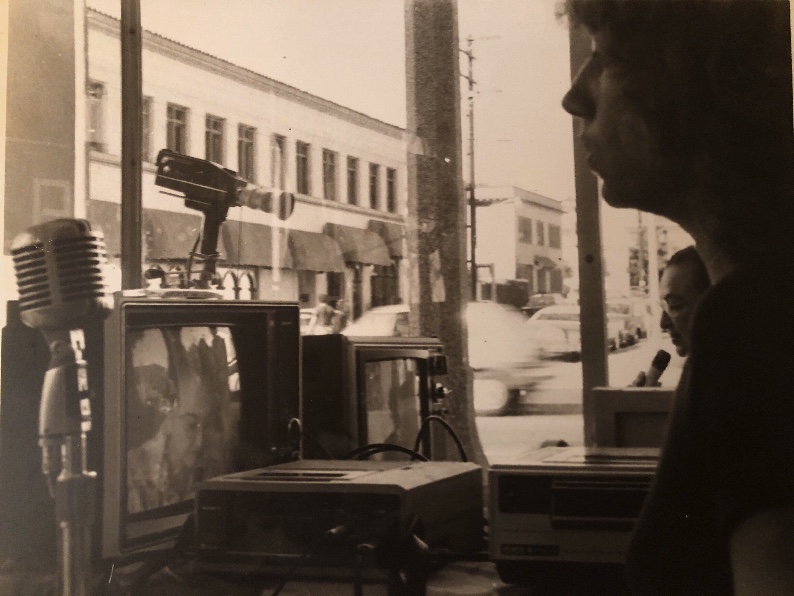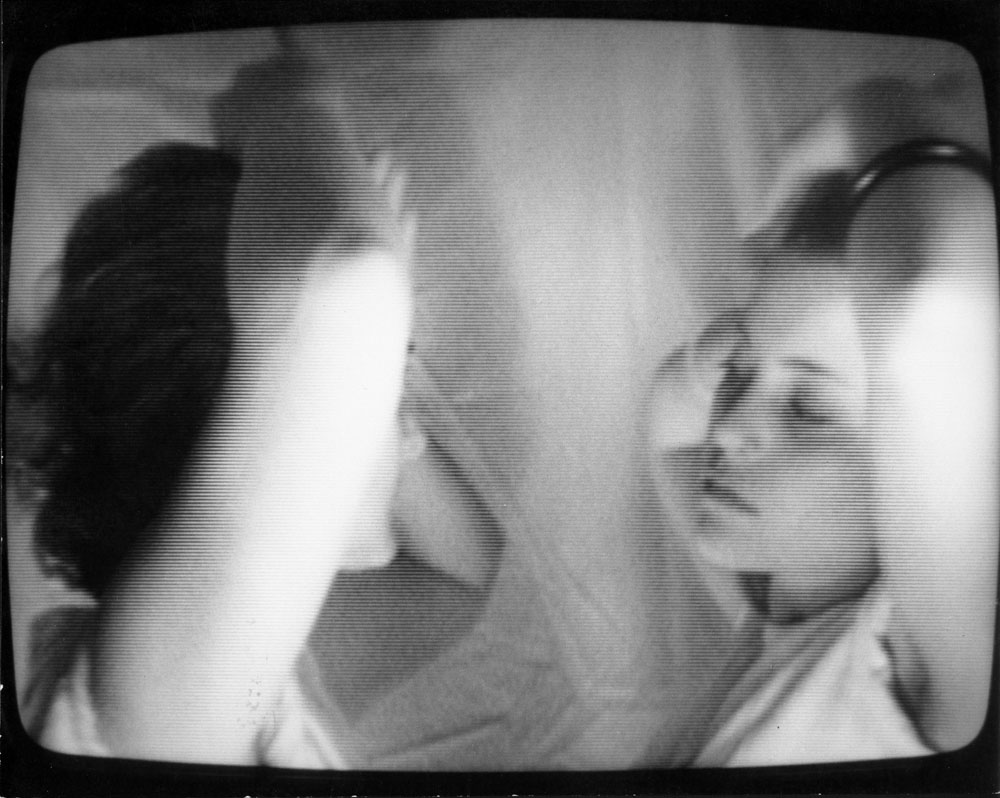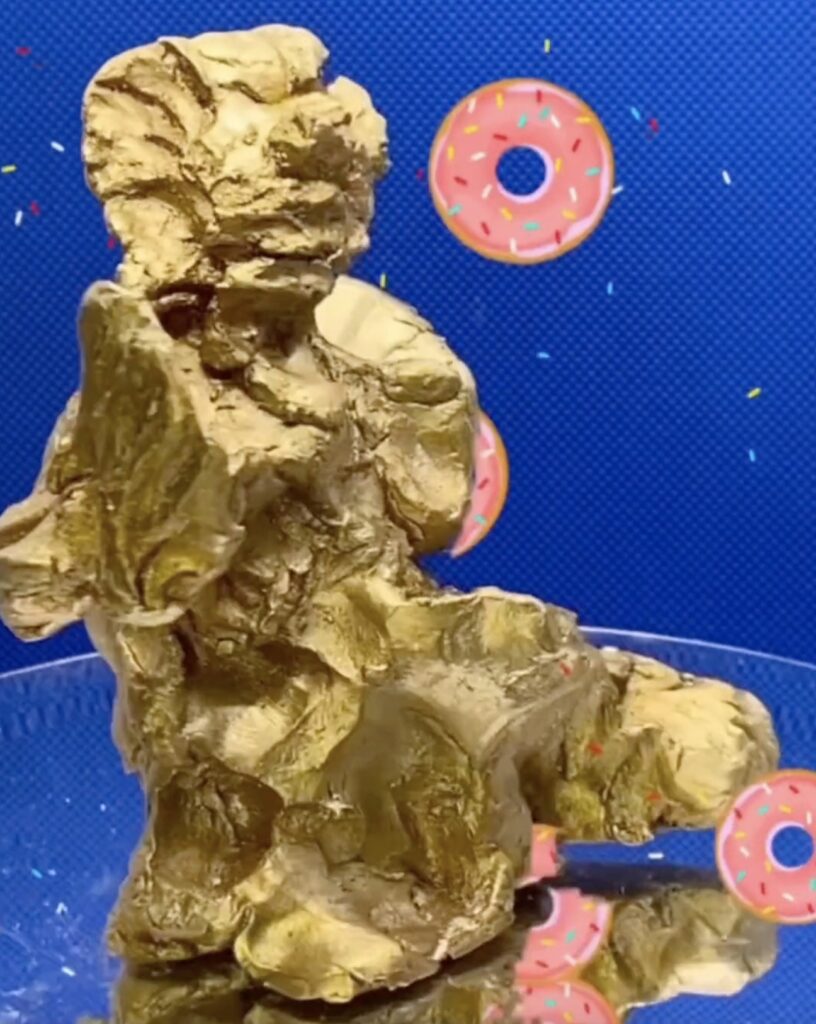Monday October 30 – Thursday November 2, 11pm
Nina Sobell
Intermedia Interactivity
Artist in person — Event in person & online

Microscope is very pleased to present a screening of works by New York-based artist Nina Sobell featuring a selection of videos spanning more than 50 years, from 1971 – shot with a Sony Portapak — to her present-day inquiries using social media platforms and AI. Through her very uniquely empathic lens, she has proposed a type of art based on human interactions through physical installations as well as through other forms of communication mediated by new tools and machines. Sobell will be in attendance and available for a Q&A following the screening. The event is taking place in-person as well as online.
Nina Sobell took an early interest in the idea of interactivity, sculptural environments, performance, video, as well as other electronic and early web technologies. From her experimentations with foam rubber sculptures and environments circa 1967 — as well as ephemeral sculptures made of dead leaves or grass — the search for audience participation in Sobell’s public installations of that time led her to embrace the medium of video, not only as a way to document those interactions, but also to prolong and extend such outdoor experiences into indoor spaces via CCTV cameras and monitors.
Subsequent works using TV monitors, telephones, and eventually the addition of the connective possibilities of the world wide web — such as her collaboration with Emily Hartzell VirtuAlice from 1995, which consisted of a wireless tele-robotic webcam on a motorized chair that took sequential images that were shared in real time and was able to be controlled remotely by users on the web or passerby — emphasized the elements of live play and performance, blurring the boundaries between audience and artist, personal and public, real and virtual.
The evening begins with a 1993 documentary by Hartzell, “Pioneer in Interactivity” that discusses the artist’s works through actual footage including of such groundbreaking pieces as BrainWave Drawings, initiated in 1972, in which the viewers’ brain activity is captured through electroencephalographic electrodes and reproduced on a TV screen, an “electronic theater” where participants are both actors and observers.
The program continues with early videos such as “Hair Comb” and “Elements,” from 1973, which are testaments to the independence offered by the medium, presenting performances and stagings of sculptures for the camera while investigating the visual possibilities of black & white video. Other works including “BrainWave Drawings (1973-1983)” involves documentations of multiple iterations of a participatory installation, while “Breaking Glass” (1973) is edited from footage of an extreme performance for the camera. “Murder with Mother” (1982), “Into the pot you go” (1982) and others, find the artist revisiting personal trauma’s through allegorical and more theatrical restagings. Later works, consider the brain and its functions — both conscious and unconscious — and more recently involve AI-generated imagery based on the prompt “Humans evolving into animals.”
General Admission $10
Member Admission $8
_
Since 1969, New York-based artist and sculptor Nina Sobell has been active internationally in pioneering internet performance art actions, in addition to working with videos exploring neuroscience, computers, memory, human relationships, communication, public interactivity and sculpture. She is the recipient of numerous awards, including grants from the NEA and NYSCA for her pioneering video performance art. Sobell taught at UCLA and SVA, was a visiting Lecturer at Goldsmiths College, University of London, and was artist-in residence at the Center for Advanced Technology, Courant School of Computer Science and ITP Tisch at New York University as well as Banff Centre for the Arts in Canada. She received a BFA sculpture and printmaking from Tyler School of Art, Temple University, and an MFA in sculpture from Cornell University. Her sculptures, installations, and video art have been widely screened and exhibited internationally at such places as MIT, Getty Museum and Research Institute, Blanton Museum of Art and Institute of Contemporary Art, London. Her work is in the collections of the Getty Museum; de Saisset Museum; Banff Centre for the Arts; Manchester Gallery, England; Acme Gallery Archives in Whitechapel Gallery, London; The Blanton Museum, Austin; CAM, Houston; ZKM, Karlsruhe; Archivio Storico delle Arti Contemporanee, La Biennale di Venezia; ICA London; DIA Foundation; Cornell University and many other institutions; the Kramlich, Reynolds, RJFleck, Broder, Leo Kuelbs Foundation and other private collections. Video Data Bank and MLC Gallery represent her work.

Program:
Nina Sobell: Pioneer In Interactivity by Emily Hartzell
Video, color, sound, 1993, 25 minutes 40 seconds
Documentary of Nina Sobell’s work from 1968-1993.
Elements
Single-channel video, b&w, sound, 1973, 22 minutes
As implied by its title, Elements is a basic grammar of video motion, an exploration of the relationship between abstract (ideal) movement and movement as it occurs in real images and situations. In it a limited number of units of rhythm, of image, and of sound are manipulated through different combinations and permutations. For example, the opening sequence simply shows a number of different body movements all with a common rhythmic structure (tap dancing, barefoot dancing, kissing) along with sound patterns that alternately correspond with the image or are independent of it, sometimes produced by the image and sometimes discreet from it. Proceeding in sophistication from this point, the tape develops images of specific motions in different contexts (a falling paper, a huge sheet of polythene, falling paper ash), or of a specific kind of image produced in different ways (fire from gas rings, a burning pier, burning paper). Many of the images are (or are revealed to be) extremely beautiful in their own right, but it is the thematic and structural coherence of this tape, the clarity and precision of its development that make viewing it so exciting and rewarding. — David E. James
Hair Comb
Single-channel video, b&w, sound, 1973, 4 minutes
Flirting with Susan, making moves on her transforming her through miming actions reflecting our masculine selves. — NS
Flip Flops
Single-channel video, b&w, sound, 1973, 1 minute 10 seconds
A flaccid penis bounces in rhythm against a bouncing woman’s buttocks and breasts; when the penis hardens, the piece ends. — NS
Jump Set
Single-channel video, b&w, sound, 1973, 2 minutes
Two cameras are focused on two couples, one at each end of a couch. Two (m/f ) couples are sitting on the couch. Each one converses with the other’s partner; two are leaning forward while the other two are leaning back alternately. They are partially undressed. The men have their pants off, keeping on their shirts; the women are bare breasted keeping on their pants. They converse with no particular acknowledgement of their partial nudity. At both ends of the couch, there are closed circuit monitors, each person on the couch is able to see themselves. Another camera is focused on a couple (m/f ) in close proximity to the couples on the couch, who are jumping and bouncing to a consistent beat. The man stands on a stool, his flaccid penis flopping level with the woman’s flopping breasts. Another camera focuses on posted phrases like „Transient Pleasures” and „When the Talking is Over, the Silences are Worth Waiting For”. In interface, the images appear randomly, intermittently with no fixed time or expected result. It’s a play upon the typical cocktail party mentality; each one fantasizing about the other, more interested in their own images, and subtext conversations they are having with themselves. — NS
Breaking Glass
Single-channel video, b&w, sound, 1973, 2 minutes 23 seconds
In 1973 I broke shards of glass and mirror, collected over a couple of months time, without any eye protection, having the camera move from my eyes to my mouth to my hands and the glass and back again capturing the internal and external reaction to the action. Breaking myself, crisscrossing in front of monitor playing back Breaking Glass bringing it all full circle. — NS
Murder With Mother
Single-channel video, color, sound, 1982, 2 minutes 48 seconds
Re-enactment of real childhood incident when my mother tried to kill me and herself. — NS
Into The Pot You Go
Single-channel video, color, sound, 1982, 8 minutes 50 seconds
“…I am asking baby chicky to identify itself by looking at different drawings. Then I am trying to teach baby chicky how to walk and talk. I warn baby chicky that if it isn’t able to walk or talk then it will have to go into a pot and be cooked and eaten because in our society if you can’t walk and can’t talk you aren’t much good and of no use to anyone, so alas baby chicky ends up in the pot.” — NS
BrainWave Drawings (1973-83)
Single-channel video, color, sound, 1973-83, 5 minutes 23 seconds
BrainWave Drawings, a visualization of the synchronous emittance of the brainwave patterns of two people simultaneously recorded by an electroencephalograph is dissolved over their faces; thus creating a mental and physical moving portrait of their non-verbal communication, interacted with by them in real-time. — NS
On loan from ZKM Center for Art and Media, Karlsruhe, Germany
Left Brain/Right Brain
Single-channel video, color, sound, 1990, 9 minutes 44 seconds
When the left brain is engaged in speech and the right brain is creating, it becomes more difficult for the left brain to be engaged. I kept talking until my right brain took over when I was fully engaged with the details in finishing the sculpture, I was no longer able to keep talking. — NS
Persistent Vision
Single-channel video, color, sound, 2022, 3 minutes
Persistent Vision is a sequence of images and sounds investigating the unconscious parallels between thought and experience, cognition and cosmos. Spontaneously created ‘visitors’ dance and revolve around energy centers forming centrifugal force, centered on the divine. Original sound permeates this vision. — NS
Transhumans
Single-channel video, color, sound, 2023, 42 seconds
One Second Dream
Single-channel video, color, sound, 2023, 1 second
Disintegration
Single-channel video, color, sound, 2023, 7 seconds
Fire, Ice
Single-channel video, color, sound, 2023, 14 seconds

